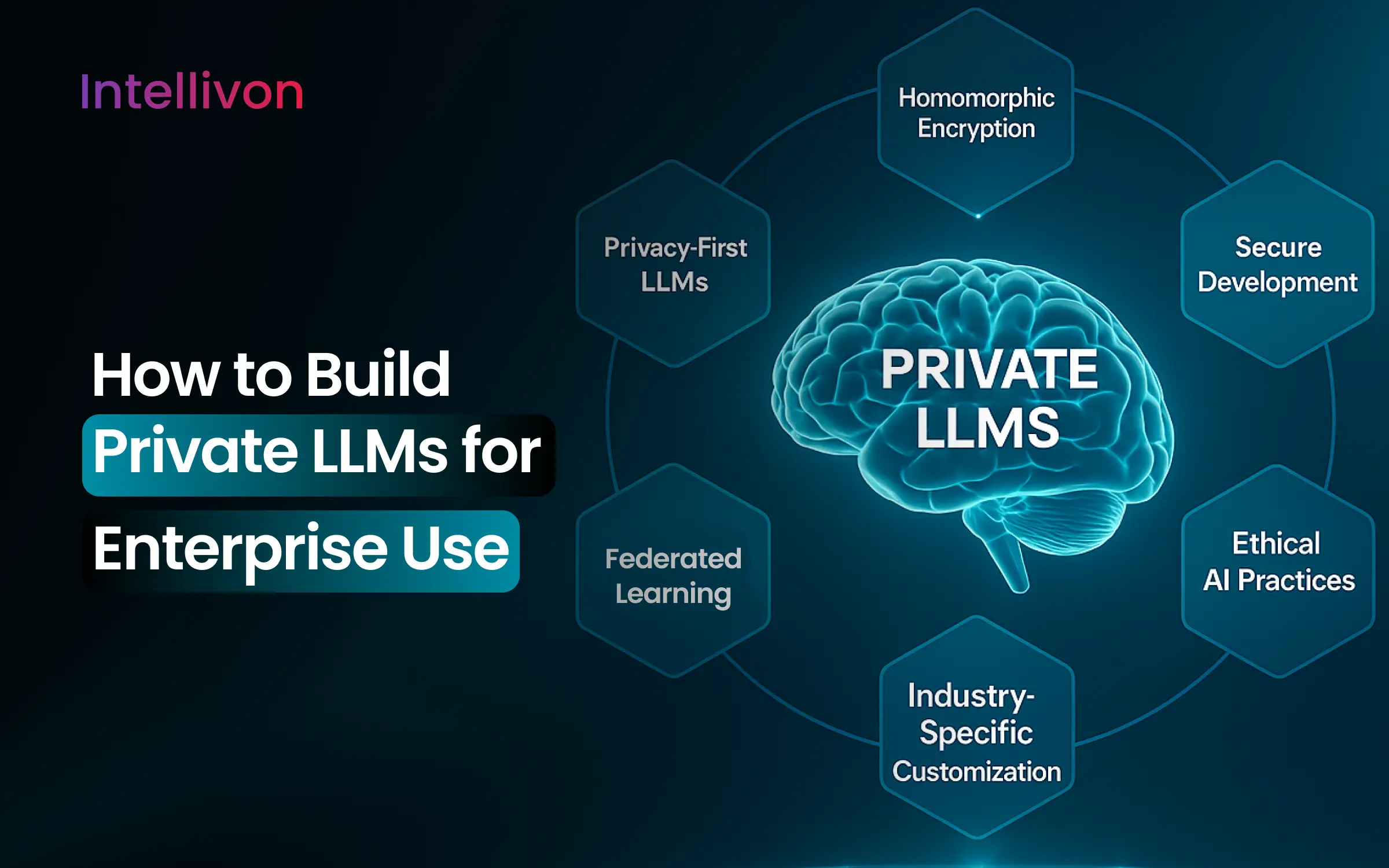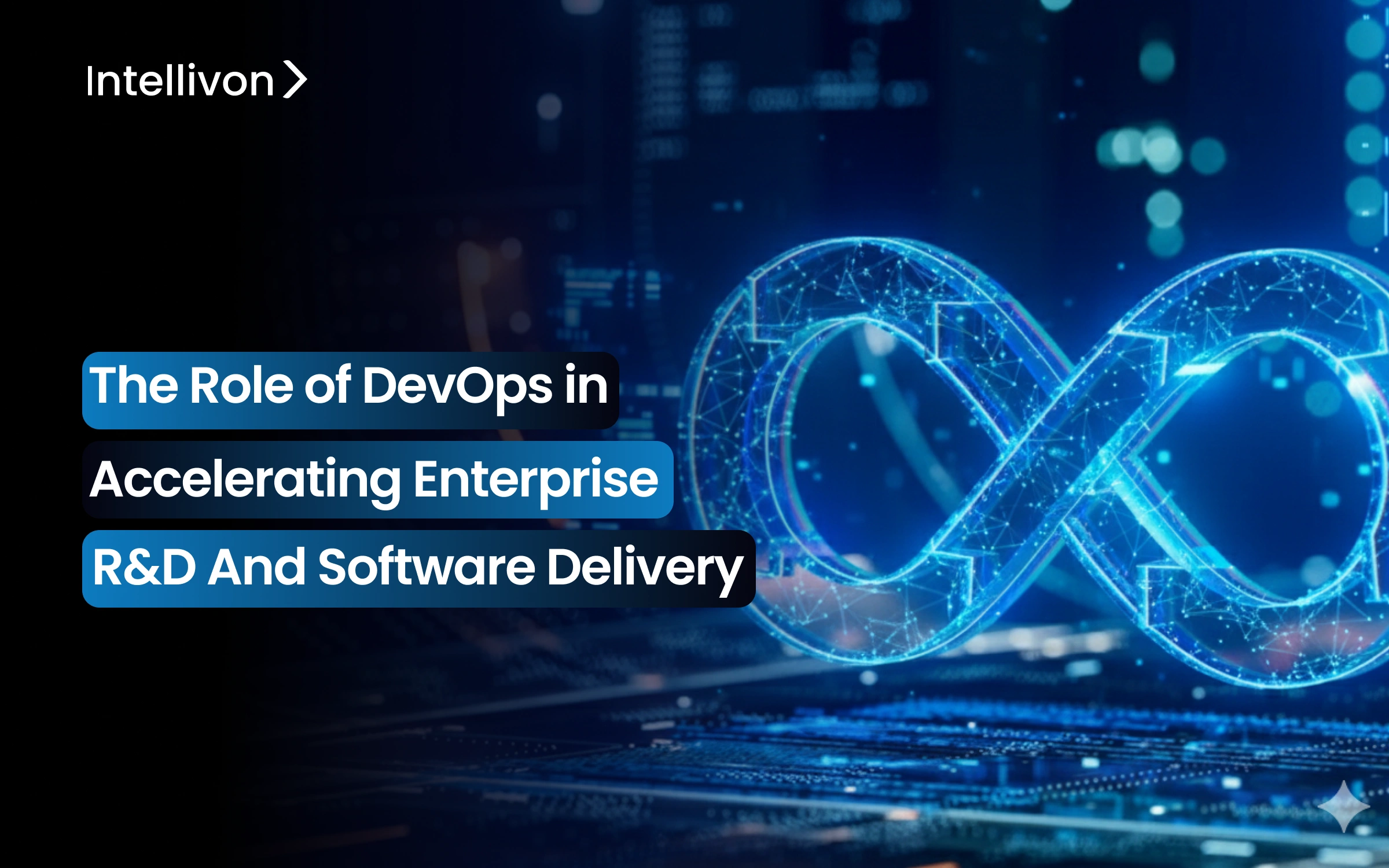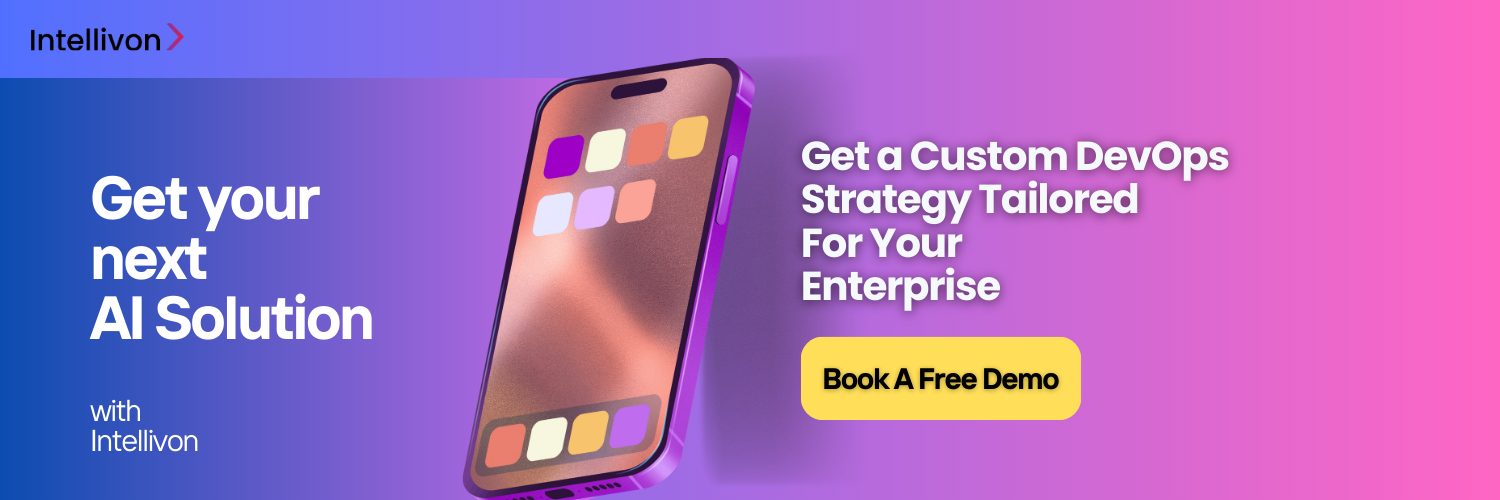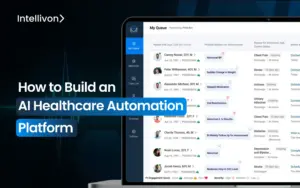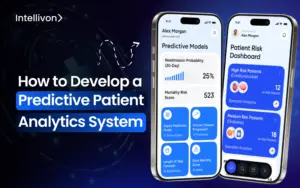In today’s fast-changing business world, large enterprises face constant pressure to innovate quickly while maintaining quality and reliability. Traditional software development methods, with long release cycles and siloed teams, can no longer keep up. These outdated approaches slow innovation and prevent companies from taking advantage of new opportunities. To stay ahead, forward-looking organizations are embracing enterprise DevOps. This modern approach reshapes how software is built, tested, and delivered at scale. By uniting development and operations, DevOps reduces time-to-market and increases agility. Teams can release updates faster, respond quickly to customer needs, and innovate with confidence.
At Intellivon, we have seen firsthand how DevOps helps enterprises break down barriers, eliminate inefficiencies, and speed up software R&D. Our proven strategies enable leaders to adopt automation, integrate security with DevSecOps, and build stronger collaboration across departments. This blog explores how enterprise DevOps transforms software delivery. You’ll discover practical tactics, common challenges, and future trends that drive lasting growth and competitive advantage.
Key Takeaways of the Enterprise DevOps Market Landscape
The global DevOps market is expanding at an impressive pace. In 2025, it is valued at $15.06 billion. By 2029, it is expected to reach $38.11 billion, growing at a strong 26.1% CAGR. This growth is fueled by enterprises demanding scalable, automated, and collaborative software development frameworks. DevOps enables faster digital transformation and long-term business resilience.
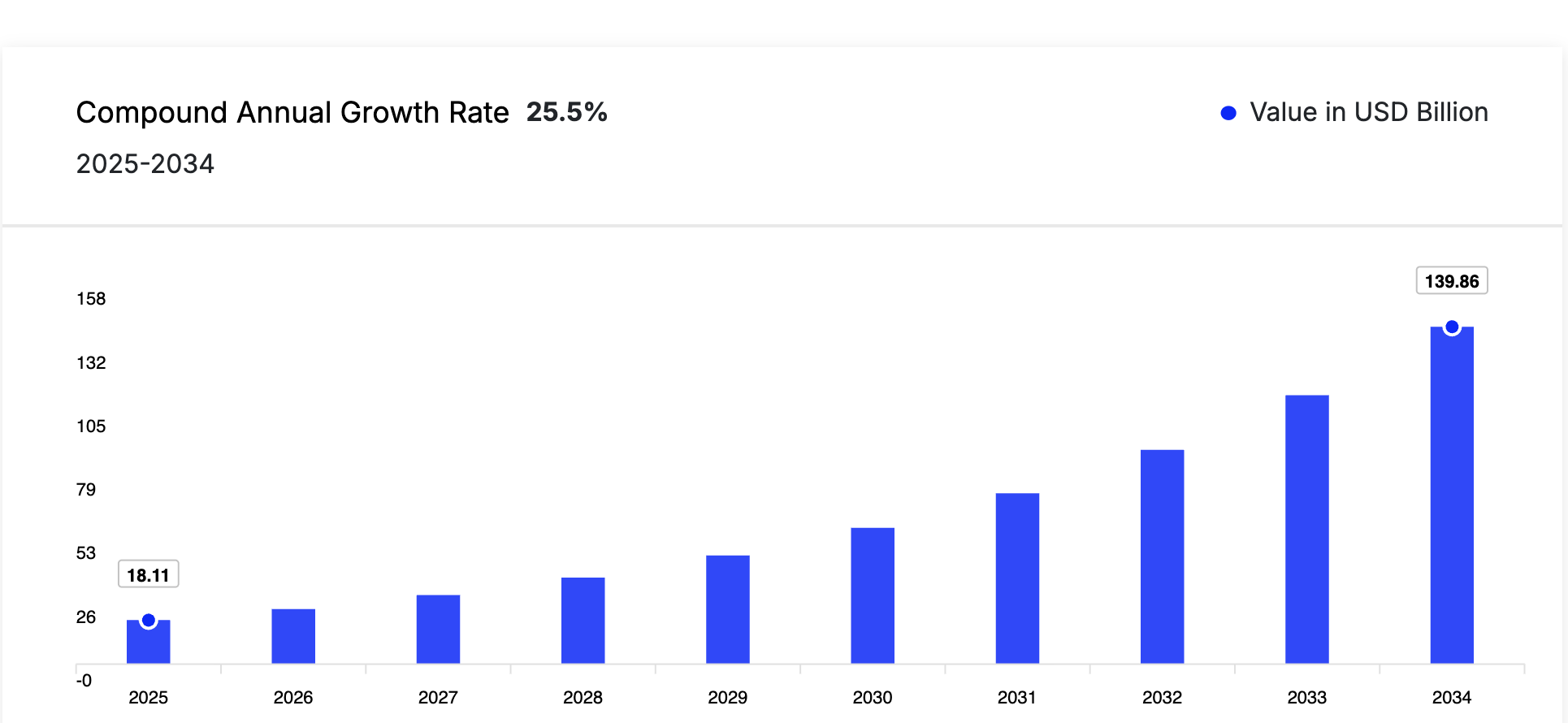
Key Market Data and Statistics
- 80–85% of organizations across industries have adopted DevOps practices.
- 90% of enterprises report measurable positive impacts from DevOps.
- 61% have seen significant improvements in product quality.
- 49% report reduced time-to-market, speeding up innovation cycles.
- Around 50% are now high-performing DevOps adopters leading the market.
- North America holds the largest share, commanding 37% of the market.
- Elite teams deploy software 208 times more often than low performers.
- Elite teams also recover from incidents 2,604 times faster.
These numbers prove that enterprise DevOps is not just a trend. It is a strategic investment that drives agility, resilience, and a stronger competitive edge.
Enterprise Bottlenecks During Software Delivery and R&D
Enterprises face many roadblocks when scaling research and development. These challenges slow delivery, raise costs, and reduce innovation speed. DevOps directly addresses these barriers and provides practical, proven solutions.
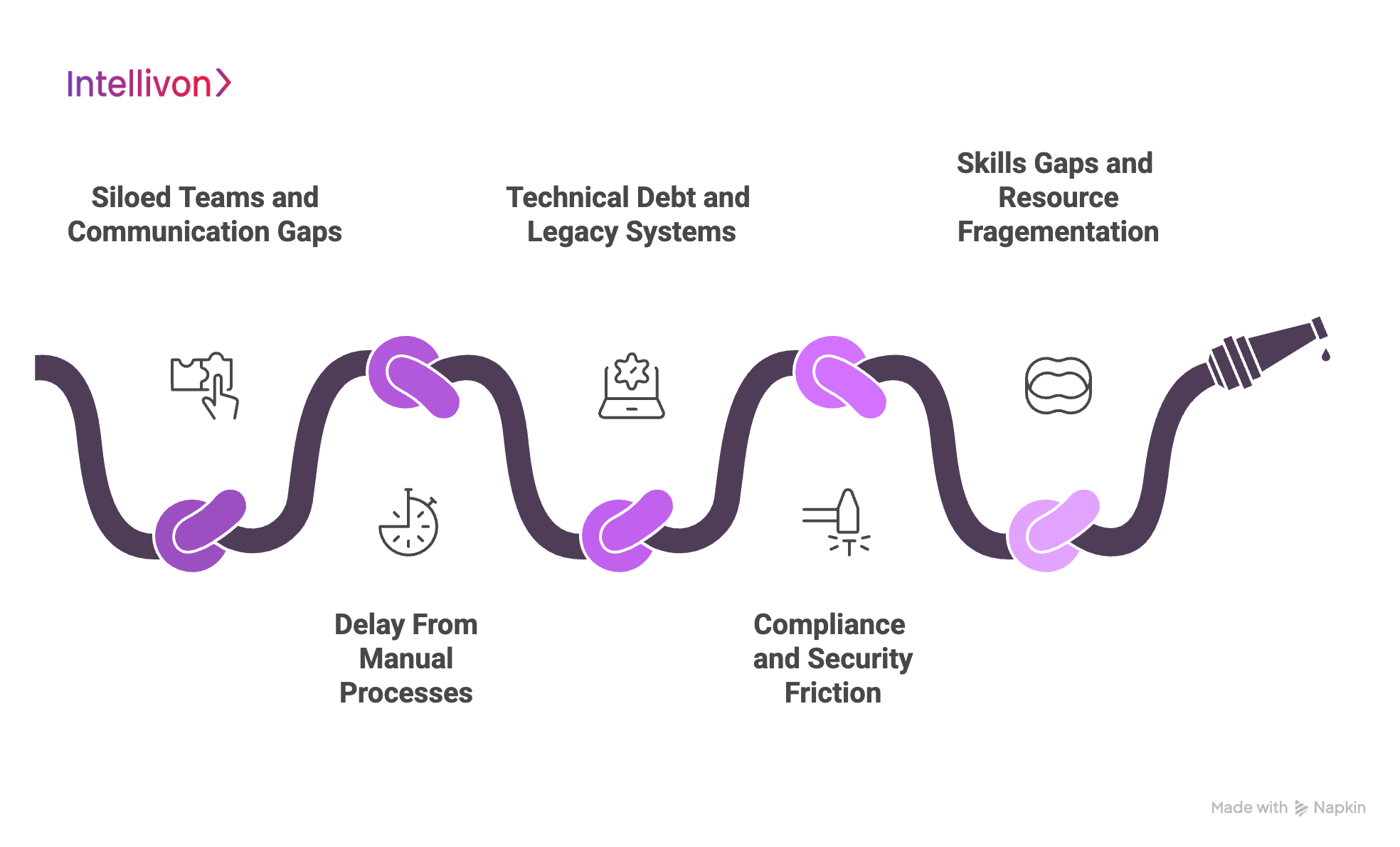
1. Siloed Teams and Communication Gaps
In large organizations, departments often work in isolation. Development, testing, and operations may follow different priorities. This creates delays. For example, when developers finish coding, operations may not be ready to deploy.
By promoting shared ownership and using collaboration tools, DevOps breaks silos. Cross-functional teams work together from planning to deployment. Amazon uses “two-pizza teams” to ensure teams remain small and collaborative. This structure avoids silos and accelerates deployment speed across their massive infrastructure.
2. Delays from Manual Processes
Many enterprises still rely on manual deployments and testing. This slows delivery and increases human error. For instance, rolling out an update across multiple regions can take days without automation.
Automation through CI/CD pipelines enables faster and error-free deployments. Tools like Jenkins or GitLab CI cut delivery time drastically. Netflix automated almost every step of deployment with its CI/CD pipeline. This lets the company push thousands of updates daily without downtime.
3. Technical Debt and Legacy Systems
Outdated code and legacy platforms weigh down enterprises. Maintaining these systems consumes resources and limits innovation. For example, banks using old mainframes face delays in adopting cloud-native apps.
DevOps encourages incremental modernization. Containerization tools like Docker and orchestration with Kubernetes help enterprises migrate gradually while maintaining service continuity. Capital One adopted containerization and microservices. This reduced dependency on legacy systems and accelerated their move to cloud-first banking services.
4. Compliance and Security Friction
Strict regulations can slow R&D cycles. For instance, medical software must undergo repeated security validations before release. These checks, while necessary, create bottlenecks.
DevSecOps integrates automated compliance checks into the pipeline. Issues are flagged early, reducing last-minute surprises. Healthcare providers adopting DevSecOps use automated vulnerability scans. This ensures HIPAA compliance while speeding up medical software delivery.
5. Skills Gaps and Resource Fragmentation
R&D projects often require niche expertise, such as AI or cloud skills. Resources are stretched thin. For example, a data scientist may support several teams, slowing progress.
DevOps promotes skill-sharing through standardized workflows. Knowledge becomes reusable, and automation reduces dependency on individual specialists. Google uses shared development environments and reusable templates. This enables engineers across teams to collaborate effectively without overburdening a small group of experts.
These examples show how DevOps removes barriers that once slowed enterprise research and software delivery. From reducing silos to accelerating deployments, the impact is clear. But solving bottlenecks is only the beginning. To understand the true value, we need to explore what DevOps really means for enterprise R&D, how it changes processes, reshapes culture, and drives measurable outcomes.
What DevOps Means for Enterprise R&D
In enterprise research and development, DevOps represents a fundamental shift in how innovation cycles and workflows are executed. It is a cultural and operational philosophy. At its core, DevOps breaks down silos between development, operations, security, and quality assurance. This fosters continuous collaboration and shared responsibility.
For R&D teams, this means faster experimentation, automated infrastructure provisioning, and continuous feedback loops. These elements are critical to driving innovation at scale.
1. Agility in Research Workflows
When DevOps principles are applied, research evolves from rigid silos into collaborative roadmapping. Stakeholders engage early and often, aligning goals across departments. Static, lengthy R&D cycles become dynamic, iterative loops where hypotheses are tested and refined quickly.
2. Role of Infrastructure as Code (IaC)
With Infrastructure as Code, research environments are reproducible, scalable, and consistent. Tools like Terraform and Ansible allow experimental infrastructure to be provisioned automatically. This eliminates manual setup delays and reduces human error.
For example, a pharmaceutical R&D team can spin up identical cloud environments to test new drug discovery algorithms, ensuring results are consistent and reproducible.
3. How DevOps Works in R&D Environments
1. Continuous Planning
Traditional isolated roadmaps give way to collaborative R&D planning. Teams engage in iterative goal-setting, prioritizing experiments that deliver maximum business and research value.
2. Experimental Infrastructure
IaC tools like Terraform and Ansible automatically create flexible, consistent research environments. This removes setup bottlenecks and frees researchers to focus on experiments rather than configurations.
3. Data Pipeline Automation
Research often involves massive amounts of data. Automating data pipelines improves reproducibility and accelerates insights. Integrating CI/CD into research workflows allows rapid validation and deployment of algorithms or prototypes.
For instance, AI researchers can automatically train and test models using CI/CD pipelines, speeding up iterations that would otherwise take weeks.
4. Collaborative Development
Cross-functional teams, which include developers, data scientists, testers, and operations specialists, work in unison. Shared ownership, agile practices, and continuous delivery pipelines improve cycle times, quality, and research output reliability.
By embedding DevOps culture, tools, and practices into R&D, enterprises unlock new levels of speed, agility, and innovation. This cultural and technical shift is essential for maintaining a competitive edge in fast-changing markets.
The Role of DevOps in Enterprise R&D Acceleration
DevOps is transforming enterprise R&D by enabling faster innovation and more efficient workflows. Traditional R&D often suffers from slow cycles, siloed teams, and fragmented processes. DevOps breaks down these barriers and fosters a collaborative, integrated culture.
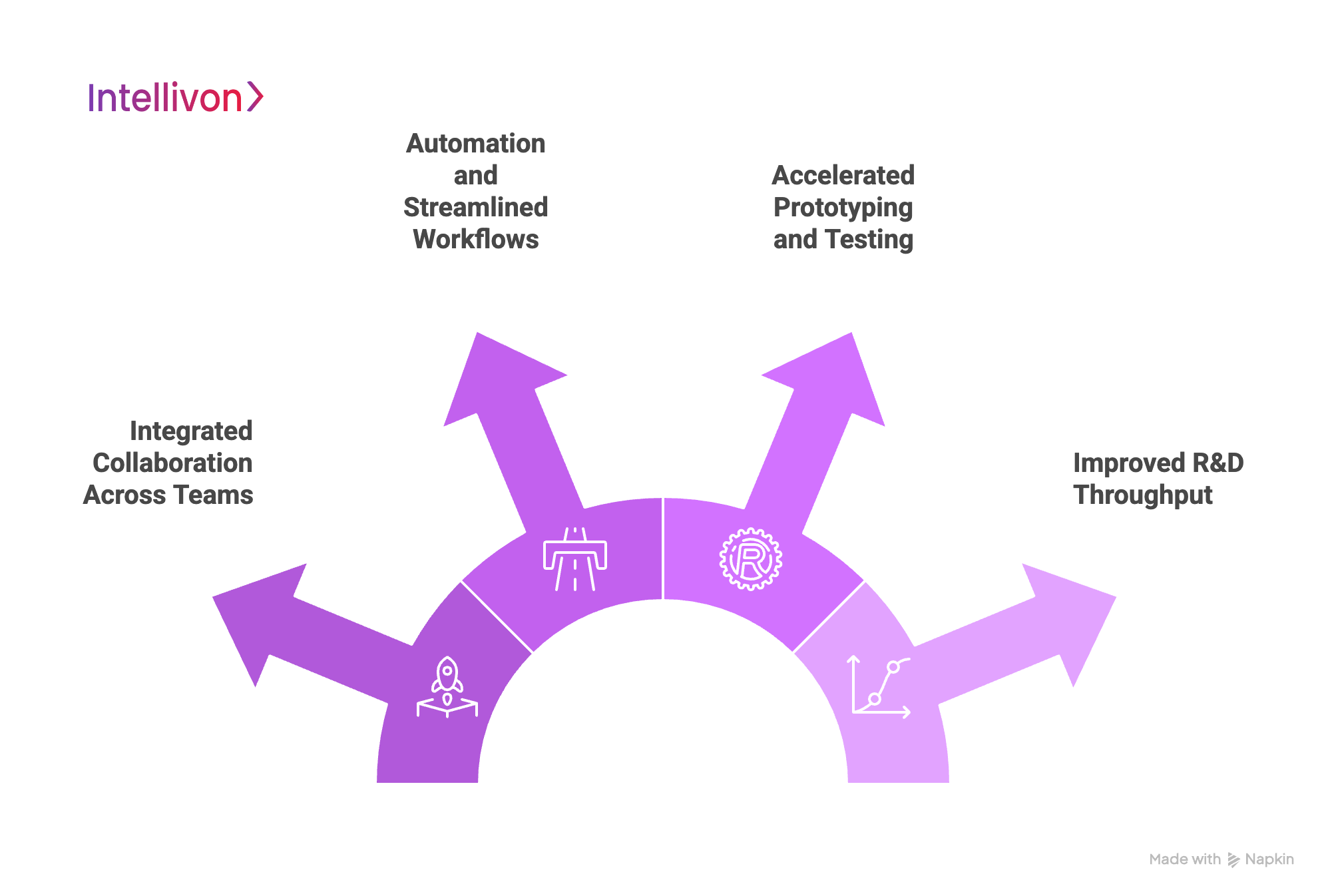
1. Integrated Collaboration Across Teams
DevOps aligns development, operations, and quality teams into continuous improvement loops. By encouraging shared ownership, teams communicate better, resolve issues faster, and reduce bottlenecks.
Example: Cross-functional AI research teams can iterate on models quickly because developers, data engineers, and QA specialists work in sync.
2. Automation and Streamlined Workflows
Automation is a cornerstone of DevOps. Continuous integration (CI) and continuous delivery (CD) pipelines streamline R&D workflows. Manual tasks like deployments and environment setups are minimized, allowing researchers to focus on innovation.
Example: A pharmaceutical company using automated testing pipelines can validate new drug discovery algorithms in hours instead of weeks.
3. Accelerated Prototyping and Testing
DevOps enables rapid prototyping, testing, and deployment. Infrastructure-as-Code (IaC) tools like Terraform provide reproducible environments, while automated tests ensure reliability. This allows teams to test multiple hypotheses quickly and safely.
Example: Tech companies spinning up sandbox environments on demand can validate several AI prototypes simultaneously, accelerating time-to-insight.
4. Improved R&D Throughput
With DevOps practices, enterprises experience higher throughput and better-quality research outputs. Teams can iterate faster, reduce errors, and maintain consistent standards. Over time, this leads to sustainable competitive advantage.
Example: Companies like Netflix and Spotify leverage DevOps to continuously experiment and deploy new features, keeping them ahead of competitors.
Technology Requirements for R&D Enterprise DevOps
Implementing DevOps in enterprise R&D requires the right set of tools and technologies. These solutions ensure faster, reproducible, and reliable research workflows.
1. Version Control Systems (VCS)
Tools like Git and Mercurial are essential for managing research code. They allow multiple researchers to collaborate simultaneously, track changes, and revert to previous versions when needed.
Example: In a data science team, using Git ensures that every model iteration is documented. Researchers can quickly test hypotheses without overwriting each other’s work.
2. Container Technologies
Containers, such as Docker, provide reproducible and isolated environments. This guarantees that experiments run consistently across different machines or cloud setups.
Example: AI teams can package code and dependencies into Docker containers, ensuring that experiments run identically whether on a local workstation or a cloud cluster.
3. Continuous Integration and Delivery (CI/CD) for Research
CI/CD tools like Jenkins and GitLab CI automate testing, validation, and deployment of research outputs. They allow teams to catch errors early and accelerate delivery cycles.
Example: A genomics lab can automatically test new data analysis scripts every time changes are made, reducing manual validation and speeding up results.
4. Infrastructure as Code (IaC)
IaC tools, including Terraform and Ansible, enable automated, consistent provisioning of research infrastructure. Teams can spin up complex environments in minutes instead of days.
Example: Cloud-based R&D teams can create identical environments for multiple experiments, ensuring reproducibility and eliminating setup delays.
These technologies collectively form the backbone of enterprise DevOps for R&D, enabling faster experimentation, consistent results, and seamless collaboration across distributed teams.
Challenges in R&D Enterprise DevOps Implementation
While enterprise DevOps brings significant benefits, implementing it in R&D environments presents unique challenges. Understanding these obstacles is critical for planning successful adoption strategies and avoiding common pitfalls.
1. Legacy Systems and Technical Debt
Outdated infrastructure and accumulated technical debt can severely limit DevOps implementation. Legacy platforms often do not integrate easily with modern CI/CD pipelines, automated testing, or containerized environments. For instance, banks relying on decades-old mainframes face difficulties deploying iterative R&D workflows without impacting critical operations.
These challenges require enterprises to adopt incremental modernization, such as containerization, microservices, and step-by-step cloud migration, which reduces risk while enabling faster experimentation and deployment.
2. Skills Gaps
Enterprise R&D projects demand specialized skills in cloud technologies, automation, IaC, and CI/CD practices. However, many teams are staffed with researchers or developers who lack DevOps experience. For example, a data science group may excel at building models but struggle to implement Jenkins pipelines or Terraform scripts. Skills gaps can delay adoption, create inconsistencies, and increase dependency on a few experts.
Addressing this requires cross-training, hiring DevOps-savvy talent, and fostering a culture of continuous learning to ensure teams can manage complex workflows efficiently.
3. Integration Complexity
Integrating new DevOps tools into existing R&D systems and workflows can be highly complex. Misaligned processes across departments may create friction rather than efficiency gains. For example, deploying a CI/CD pipeline that spans multiple research groups requires standardized version control practices, automated testing frameworks, and coordination between developers and operations teams.
Without careful planning, integration may introduce errors, slow down workflows, or require constant manual intervention. Proper documentation, workflow standardization, and pilot implementations can mitigate these risks.
4. Security and Compliance Concerns
Regulated industries like healthcare, finance, and pharmaceuticals face heightened security and compliance pressures. Integrating these requirements into DevOps pipelines can be challenging, as teams may fear that faster release cycles compromise governance. For instance, medical software updates must comply with HIPAA regulations, requiring repeated checks before deployment.
DevSecOps addresses this by embedding automated security and compliance testing into the CI/CD pipeline, ensuring that speed does not come at the expense of safety or legal compliance.
Best Practices for R&D Enterprise DevOps
Implementing DevOps requires structured best practices to maximize innovation, speed, and reliability. Intellivon helps enterprises adopt these practices, enabling teams to accelerate research cycles and deliver high-quality results.
1. Foster a Collaborative Culture
DevOps thrives in organizations where teams share ownership of projects and outcomes. Intellivon guides enterprises to break down silos and foster collaboration between developers, testers, operations, and data scientists. Open communication, regular stand-ups, and cross-functional training are emphasized.
Example: Spotify’s squad model promotes autonomous teams with shared goals. Intellivon applies similar frameworks to ensure rapid experimentation while maintaining alignment across departments.
2. Adopt CI/CD
CI/CD pipelines automate testing, integration, and deployment, reducing errors and accelerating delivery cycles. Intellivon implements CI/CD strategies tailored for R&D, ensuring frequent integration catches issues early and accelerates innovation.
Example: Netflix deploys thousands of updates daily. Similarly, Intellivon enables enterprise R&D teams to safely iterate on prototypes and features at high speed.
3. Leverage Infrastructure as Code (IaC)
IaC tools like Terraform and Ansible allow teams to provision consistent, reproducible research environments. Intellivon sets up automated infrastructure to eliminate setup bottlenecks and reduce human error.
Example: Pharmaceutical R&D teams can replicate testing environments for multiple experiments. Intellivon ensures these environments remain consistent and scalable across projects.
4. Automate Testing and Quality Checks
Automated testing ensures research outputs meet quality standards before deployment. Intellivon integrates unit, integration, and security tests into R&D pipelines, reducing defects and accelerating feedback loops.
Example: AI teams can validate models automatically, detecting errors early. Intellivon implements these pipelines to speed experimentation without sacrificing quality.
5. Measure and Monitor Performance
Tracking KPIs like cycle time, deployment frequency, and error rates helps identify bottlenecks. Intellivon sets up dashboards and monitoring tools so enterprises can continuously improve R&D processes.
Example: Cloud-based enterprises track CI/CD metrics to optimize pipelines. Intellivon ensures teams focus on the most impactful improvements.
6. Embrace DevSecOps Practices
Security is embedded early in the workflow. Intellivon implements automated compliance and vulnerability checks, maintaining speed while protecting critical data.
Example: Healthcare software teams embed HIPAA scans into CI/CD pipelines. Intellivon ensures security requirements are met without slowing innovation.
By leveraging Intellivon’s expertise, enterprises can accelerate R&D, increase innovation throughput, and maintain high-quality outputs while minimizing operational risks.
DevOps in the Enterprise Software Delivery
DevOps is transforming the traditional Software Development Life Cycle (SDLC). Unlike conventional methods, which are linear and siloed, DevOps integrates development, operations, and quality assurance into a continuous, collaborative workflow. This approach accelerates software delivery, reduces errors, and improves product quality.
Traditional SDLC often follows sequential phases like requirement gathering, development, testing, and deployment. Each stage waits for the previous one to complete, which slows delivery and creates handoff issues.
DevOps replaces this linear model with a continuous, iterative process where development, testing, deployment, and feedback occur simultaneously. The DevOps lifecycle comprises seven key phases that support this continuous, agile process:
1. Continuous Development
This phase focuses on writing code continuously based on evolving requirements. Teams plan and develop features in small, manageable increments rather than large, monolithic releases.
Software teams at Microsoft use feature branches and agile sprints to ensure development remains iterative and aligned with business goals.
2. Continuous Integration (CI)
CI involves automatically merging code changes into a shared repository multiple times a day. Automated builds and tests ensure that new code integrates smoothly without introducing errors.
Netflix uses CI pipelines to validate thousands of code changes daily, reducing integration issues and keeping its platform stable.
3. Continuous Testing
Automated testing verifies functionality, performance, and security at every step. This ensures that bugs are detected early, reducing costly post-release fixes.
Example: QA teams at Google automate unit, integration, and regression tests to maintain high software quality across frequent updates.
4. Continuous Deployment (CD)
CD automates the release of validated code to production. This minimizes manual intervention and accelerates delivery cycles.
Example: Facebook deploys code multiple times daily using CD pipelines, enabling new features and updates to reach users quickly.
5. Continuous Monitoring
Monitoring tracks application performance and system health in real time. Teams can detect anomalies, prevent downtime, and respond proactively to issues.
Example: Uber uses monitoring dashboards to track microservices performance and ensure seamless rider experiences worldwide.
6. Continuous Feedback
DevOps incorporates user and system feedback into the development process. Teams adjust features and workflows based on insights, improving software quality and customer satisfaction.
Example: Shopify collects telemetry and user feedback continuously to prioritize updates and refine its platform efficiently.
7. Continuous Operations
This phase ensures stable and reliable operations. Automation, orchestration, and infrastructure management maintain uptime and resilience across enterprise systems.
Example: Capital One uses automated operations and IaC to maintain consistent environments, reducing downtime while scaling services securely.
This DevOps lifecycle enables enterprises to deliver software faster, maintain higher quality, and respond quickly to changing market demands. By integrating these phases, companies can transform traditional SDLC into a flexible, agile, and outcome-focused process.
How DevOps Works in Enterprise Software Development
Enterprise DevOps transforms software development by combining automation, collaboration, and continuous feedback. It ensures faster, reliable releases while maintaining high-quality standards. Key components include CI/CD pipelines, automated testing, IaC, and containerization.
1. CI/CD Pipeline Architecture
The CI/CD pipeline automates integration, testing, and deployment of code changes. Continuous Integration ensures that code from multiple developers merges seamlessly, while Continuous Deployment pushes validated updates to production automatically.
2. Automated Testing Integration
Automated testing validates functionality, performance, and security at every stage of the pipeline. It eliminates repetitive manual testing, catches defects early, and ensures software quality.
3. Infrastructure as Code (IaC) Implementation
IaC tools like Terraform and Ansible allow enterprises to automate environment provisioning. Infrastructure is defined through code, enabling reproducible, scalable, and consistent setups for development, testing, and production.
4. Containerization and Orchestration
Containers, such as Docker, package applications and dependencies into isolated, portable units. Orchestration platforms like Kubernetes manage container deployment, scaling, and maintenance, improving reliability and resource efficiency.
By combining CI/CD, automated testing, IaC, and containerization, enterprise DevOps creates a robust, scalable, and agile software development ecosystem. This approach reduces downtime, accelerates innovation, and allows enterprises to deliver high-quality software continuously.
The Role of DevOps in Enterprise Software Delivery Acceleration
Implementing DevOps in enterprise software delivery provides measurable advantages that improve speed, quality, and efficiency. Intellivon helps enterprises leverage these benefits to accelerate releases, streamline operations, and maintain a sustainable competitive advantage.
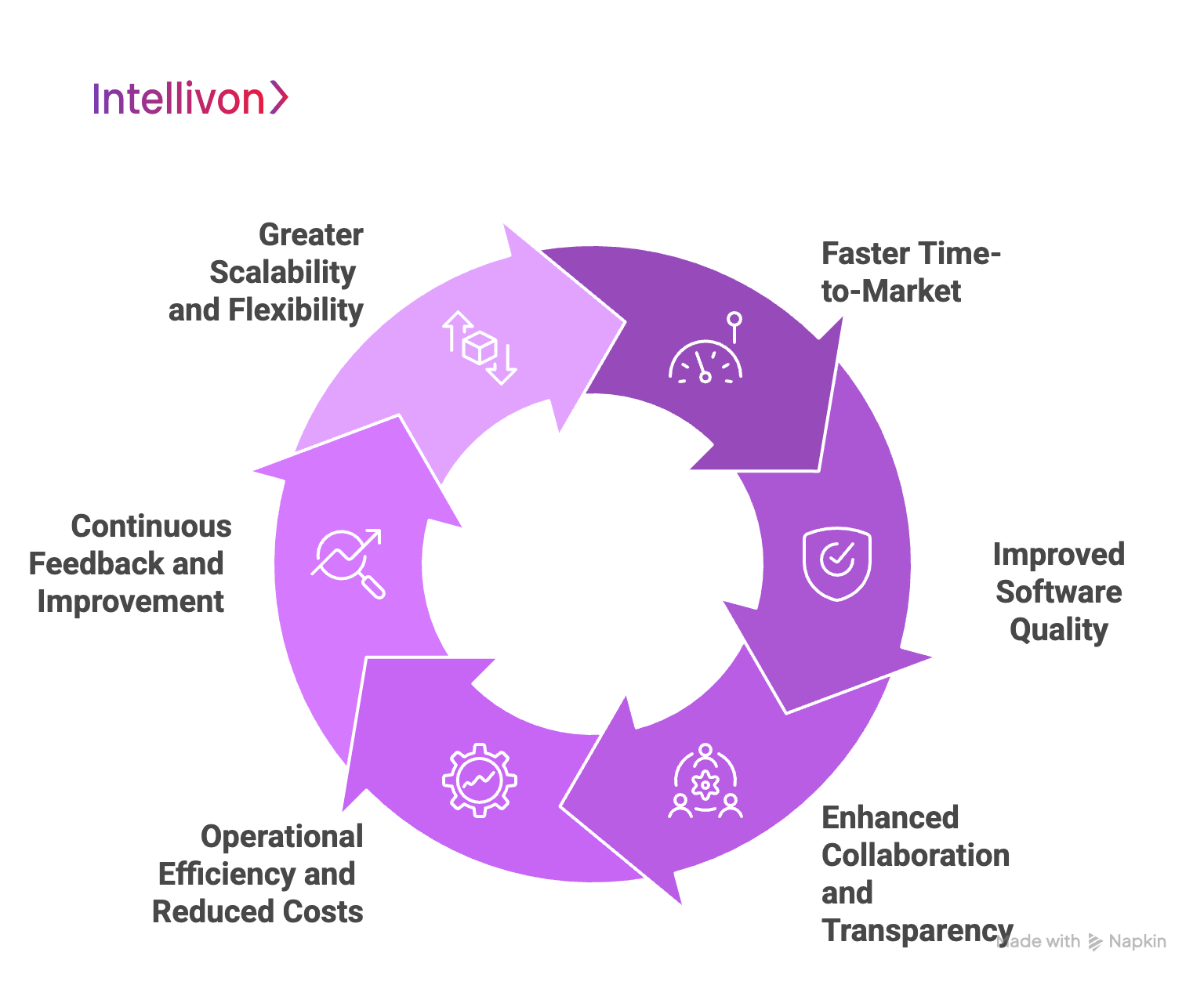
1. Faster Time-to-Market
DevOps shortens release cycles by integrating development, testing, and deployment into continuous workflows. This enables teams to release features in smaller increments more frequently, reducing delays caused by manual handoffs.
Intellivon ensures pipelines are optimized for rapid iteration, automating repetitive tasks and enabling enterprises to respond quickly to market demands, shifting business priorities, or customer feedback. Faster releases allow companies to capitalize on new opportunities before competitors.
2. Improved Software Quality
Continuous integration, automated testing, and monitoring reduce bugs, defects, and system failures. With DevOps, software undergoes multiple validations throughout the development lifecycle, ensuring higher reliability.
Intellivon implements robust quality assurance pipelines that catch issues early and maintain consistent standards across environments. This leads to software that is stable, secure, and aligned with business requirements, ultimately improving customer satisfaction and reducing costly post-release fixes.
3. Enhanced Collaboration and Transparency
Breaking down silos between development, operations, and QA fosters open communication, shared ownership, and accountability. Teams can resolve issues faster and align on project goals more effectively.
Intellivon promotes cross-functional collaboration through structured workflows, standardized processes, and transparent reporting. This enables enterprises to make informed decisions, anticipate risks, and ensure that all stakeholders are aligned on priorities and timelines.
4. Operational Efficiency and Reduced Costs
Automation reduces manual interventions, human errors, and repetitive tasks. DevOps also streamlines infrastructure management, testing, and deployments, lowering operational overhead.
Intellivon configures CI/CD pipelines, containerized environments, and IaC workflows that optimize resource usage and reduce costs. Teams can focus more on innovation rather than operational bottlenecks, allowing enterprises to deliver value faster while minimizing wasted effort and expenses.
5. Continuous Feedback and Improvement
DevOps provides real-time insights into application performance, user behavior, and system health. Teams can leverage these insights to iterate quickly and improve software continuously.
Intellivon integrates monitoring tools, analytics dashboards, and feedback loops into the development process, allowing enterprises to refine features, optimize performance, and make data-driven decisions. Continuous improvement helps organizations maintain high quality while staying aligned with evolving customer needs.
6. Greater Scalability and Flexibility
Containerization and IaC enable enterprises to scale applications, resources, and environments effortlessly. Teams can replicate infrastructure, deploy updates across multiple environments, and handle increased workloads without introducing errors.
Intellivon ensures infrastructure is reproducible, flexible, and resilient, supporting enterprise growth and dynamic business requirements. This flexibility allows organizations to scale operations efficiently while maintaining reliability and delivery speed.
By partnering with Intellivon, enterprises can accelerate software delivery, improve quality, reduce operational costs, and maintain agility, making DevOps a strategic driver of business growth and innovation.
Technology Requirements to Use DevOps for Enterprise Software Delivery
Successful DevOps adoption in enterprise software development relies on the right technology stack. These tools enable automation, collaboration, and continuous delivery while maintaining quality and security standards.
1. CI/CD Tools
CI/CD platforms like Jenkins, CircleCI, and GitHub Actions automate code integration, testing, and deployment. They help teams merge changes frequently, detect issues early, and release software faster. By streamlining these repetitive tasks, enterprises reduce errors and free up teams to focus on innovation and feature development.
2. Container Orchestration
Tools such as Kubernetes and Docker Swarm manage containerized applications efficiently. They automate deployment, scaling, and load balancing across multiple environments, ensuring consistency and high availability. Container orchestration simplifies resource management and allows teams to deliver complex applications reliably, even at scale.
3. Monitoring and Observability
Real-time application monitoring and observability are essential to detect performance bottlenecks, failures, and anomalies. Monitoring tools provide actionable insights into system health, enabling proactive issue resolution. Continuous observability ensures software operates reliably and supports faster, informed decision-making for development and operations teams.
4. Security Integration
Integrating security into the DevOps workflow, often referred to as DevSecOps, ensures that vulnerabilities and compliance issues are addressed throughout the software lifecycle. Tools for automated security scanning, vulnerability detection, and compliance checks help maintain secure software without slowing down delivery.
Leveraging these technologies enables enterprises to build a robust, automated, and secure DevOps ecosystem, improving software delivery speed, reliability, and operational efficiency.
Challenges in Using Enterprise DevOps for Software Delivery
Adopting DevOps at scale in large enterprises comes with complex obstacles. These issues can slow software delivery and affect innovation. Intellivon helps enterprises overcome these challenges while maintaining speed, quality, and compliance.
1. Complex Legacy Systems
Large enterprises often rely on decades-old software and fragmented applications. Integrating modern DevOps tools with these systems is difficult and can create delays or errors.
Intellivon bridges legacy systems with modern CI/CD pipelines, ensuring smooth integration and automated workflows without disrupting critical operations.
2. Slow Multi-Department Release Cycles
When multiple teams and departments are involved, approvals, handoffs, and inconsistent processes often delay releases.
This slows innovation and increases operational risk. Intellivon standardizes pipelines and automates approvals, helping organizations release features faster across global teams.
3. Scaling Automation Across Teams
Hundreds of developers, QA engineers, and operations staff make consistent automation challenging. Misaligned pipelines and fragmented practices reduce efficiency.
Intellivon implements scalable automation frameworks, unifying teams and processes while maintaining quality across enterprise environments.
4. Security and Compliance Challenges
Enterprises in regulated industries must comply with strict security and audit requirements. Rapid releases can create conflicts with these standards.
Intellivon integrates DevSecOps practices, embedding automated security and compliance checks into every pipeline to maintain governance without slowing innovation.
5. Limited Visibility and Metrics
Large enterprises often lack clear insight into pipeline performance, bottlenecks, and ROI. This limits leadership’s ability to make informed decisions.
Intellivon sets up centralized monitoring dashboards, providing real-time metrics and actionable insights for development speed, system health, and delivery efficiency.
By addressing these enterprise-specific challenges, Intellivon enables organizations to implement DevOps at scale. This ensures faster software delivery, higher quality, and reliable operations across large, complex environments.
Best Practices for Enterprise DevOps in Software Delivery
Implementing DevOps at enterprise scale requires structured, end-to-end execution. Intellivon takes full responsibility for designing, deploying, and managing these practices to accelerate software delivery and ensure consistent quality.
1. Unified, Collaborative Culture
Silos between development, operations, and QA slow enterprise software delivery. Intellivon establishes cross-functional collaboration frameworks, aligning teams with shared goals, transparent workflows, and integrated communication channels. This fosters faster decision-making and smoother project execution.
2. Scalable CI/CD Pipelines
Complex enterprise applications demand pipelines that can handle frequent updates and multiple teams. Intellivon builds fully automated CI/CD pipelines, including testing, deployment, and rollback mechanisms, ensuring reliable, rapid releases without manual intervention.
3. Infrastructure as Code (IaC)
Provisioning consistent environments across multiple stages is critical. Intellivon implements IaC using Terraform and Ansible, automating the creation of reproducible, scalable infrastructure for development, testing, and production, eliminating setup bottlenecks and errors.
4. Automated Testing Integration
Manual testing slows enterprise delivery and increases risk. Intellivon deploys end-to-end automated testing, like unit, integration, regression, and security, ensuring high-quality software is delivered consistently and efficiently.
5. DevSecOps Integration
Security and compliance are embedded from the start. Intellivon implements DevSecOps pipelines, automating vulnerability scanning, compliance checks, and security validations without impacting release speed.
6. Centralized Monitoring and Metrics
Enterprises require visibility across distributed systems and teams. Intellivon sets up centralized dashboards and real-time monitoring, tracking performance, pipeline efficiency, and system health, enabling proactive issue resolution and continuous improvement.
With Intellivon managing all aspects of enterprise DevOps, organizations achieve faster delivery, higher-quality software, seamless security, and scalable operations.
Enhancing Enterprise Security Through DevSecOps and RASP
Security is a top priority for large enterprises, especially as rapid software delivery and complex infrastructure increase risks. DevSecOps, adopted by over 60% of organizations, reduces incident resolution times by 75%, lowers breaches by 50%, and cuts vulnerability fixes from weeks to hours.
Intellivon’s integrated DevSecOps and RASP solutions ensure security accelerates innovation, maintains compliance, and allows enterprises to deliver secure software at scale while sustaining competitive advantage.
1. DevSecOps Integration
DevSecOps integrates security into every stage of the DevOps lifecycle. Rather than treating security as an afterthought, DevSecOps ensures that vulnerabilities are identified and resolved continuously.
1. Security-First Approach in Pipelines
Security checks are embedded into CI/CD pipelines from the earliest stages. Every code commit undergoes automated scanning for vulnerabilities, license compliance, and coding best practices. Intellivon configures these pipelines, allowing enterprises to release software quickly without sacrificing security.
2. Shift-Left Security Integration
Security is incorporated into the design and development stages. By moving testing and threat detection earlier in the lifecycle, DevSecOps reduces costly fixes post-release. Intellivon implements static code analysis, dependency scanning, and secure coding reviews, catching issues before they reach production.
3. Compliance Automation and Continuous Monitoring
Regulatory compliance is automated through integrated tools and dashboards. DevSecOps frameworks continuously monitor systems for adherence to industry standards, security policies, and internal governance. Intellivon manages monitoring and reporting, providing leadership with real-time visibility into risk posture and compliance status.
4. Runtime Application Self-Protection (RASP) Implementation
RASP enhances security by protecting applications during runtime. Unlike traditional security tools, RASP works from within the application, detecting and mitigating attacks in real time.
RASP monitors application behavior to identify threats, including injection attacks, data breaches, and unauthorized access attempts. It reacts automatically to block suspicious activity while minimizing disruption to legitimate users.
- RASP in the DevSecOps Context: Integrating RASP into CI/CD pipelines ensures applications are protected immediately upon deployment. This continuous protection complements pre-deployment security scans and provides an additional defense layer during live operation. Intellivon integrates RASP tools directly into enterprise pipelines, maintaining security without slowing delivery.
- Key Benefits of RASP: RASP offers real-time threat detection, automated responses, and significant reductions in false positives. Enterprises can detect attacks before they escalate while minimizing manual intervention. Intellivon configures automated alerts, threat logging, and mitigation strategies, ensuring proactive protection.
RASP Implementation Strategies
Effective RASP deployment requires careful planning and integration:
- Instrumentation: RASP agents are embedded into application code or runtime environments to monitor activity continuously.
- Configuration: Security rules are tailored to the enterprise application environment, balancing protection with performance.
- Monitoring: Real-time monitoring dashboards track anomalies, incidents, and automated responses.
Intellivon handles all aspects of RASP implementation, from setup and tuning to ongoing monitoring and maintenance.
RASP Integration Best Practices
- Tool Selection: Choose RASP tools that support the enterprise’s programming languages, integrate easily into existing pipelines, and have minimal performance impact. Intellivon evaluates and deploys the most suitable tools for each enterprise environment.
- Pipeline Integration: Embed RASP directly into build and deployment processes. This ensures security coverage from the first deployment through all updates. Intellivon designs pipelines that automatically enforce RASP policies at every stage.
- Continuous Monitoring and Analytics: Real-time monitoring identifies threats, tracks incidents, and provides analytics for ongoing risk assessment. This allows rapid remediation and continuous improvement.
- Compliance Benefits: Automated security controls and logging help enterprises meet regulatory requirements efficiently. Intellivon ensures compliance with standards such as ISO, SOC, and GDPR, integrating audit-ready reporting directly into DevOps workflows.
By combining DevSecOps and RASP, enterprises can deliver software faster, maintain high security standards, and reduce operational risk. With Intellivon managing implementation, integration, and monitoring, organizations achieve real-time protection, continuous compliance, and secure software delivery at scale, without sacrificing speed or innovation.
How We Ensure Enterprise DevOps Implementation Step-by-Step
Implementing DevOps at enterprise scale requires a structured, end-to-end approach. Intellivon manages the entire process, ensuring faster delivery, higher quality, and secure operations.
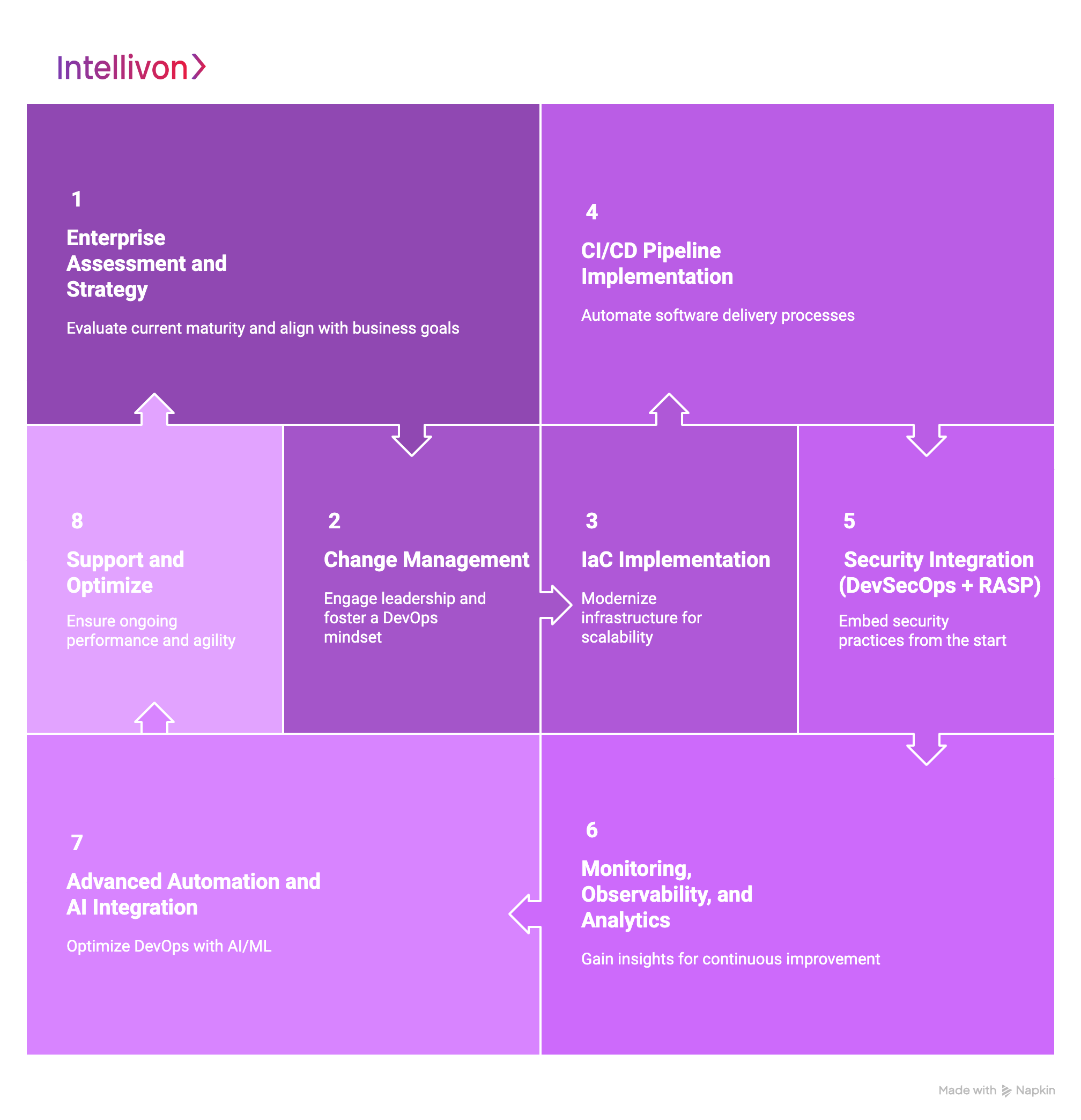
Step 1: Enterprise Assessment and Strategy
We begin with a comprehensive analysis of the organization’s current DevOps maturity. This includes evaluating workflows, tools, and processes. Based on this, Intellivon creates a custom roadmap aligned with business objectives. We define success metrics and align stakeholders to ensure measurable outcomes and organizational buy-in.
Step 2: Change Management
Successful DevOps adoption requires cultural change. Intellivon engages leadership and identifies change champions to drive adoption. We form cross-functional teams and establish collaboration frameworks. Additionally, we implement targeted training programs to develop skills and foster a shared DevOps mindset across the enterprise.
Step 3: IaC Implementation
Legacy systems often slow enterprise DevOps. Intellivon assesses and modernizes infrastructure, deploying IaC for automated, reproducible environments. We also implement cloud migration strategies and multi-cloud management to ensure scalable and resilient infrastructure.
Step 4: CI/CD Pipeline Implementation
Custom pipelines are essential for enterprise requirements. Intellivon designs CI/CD pipelines that integrate automated testing, quality gates, deployment automation, and rollback strategies. This ensures reliable, fast, and repeatable software delivery across teams and environments.
Step 5: Security Integration (DevSecOps + RASP)
Security is embedded from day one. Intellivon integrates DevSecOps practices, ensuring automated vulnerability scanning, compliance checks, and governance. RASP is deployed for real-time application protection. This approach maintains security without slowing down delivery.
Step 6: Monitoring, Observability, and Analytics
Visibility is critical in large enterprises. Intellivon implements comprehensive monitoring stacks with real-time dashboards and alerting systems. Analytics provide actionable insights into performance, bottlenecks, and system health, enabling continuous improvement and proactive issue resolution.
Step 7: Advanced Automation and AI Integration
We leverage AI/ML to further optimize DevOps. Intellivon integrates intelligent automation and predictive analytics for proactive problem detection. Autonomous deployment and self-healing systems reduce downtime and enhance operational efficiency.
By following these structured steps, Intellivon ensures enterprise DevOps is implemented efficiently, securely, and at scale, delivering faster software delivery, improved quality, and measurable business impact.
Conclusion
Enterprise DevOps is no longer optional. It is a necessary strategy for organizations that want to innovate quickly and stay competitive. Successful adoption depends on several key factors, including collaboration between teams, scalable CI/CD pipelines, automated testing, infrastructure as code, integrated security, and continuous monitoring. Companies that put these practices in place can deliver software faster, produce higher-quality outputs, and reduce operational risks.
Combining R&D workflows with DevOps pipelines speeds up innovation, ensures reproducibility, and smooths the transition from research to production. Security-first approaches like DevSecOps and RASP provide protection without hindering progress. In today’s fast-paced market, the need to adopt enterprise DevOps is clear. Organizations that take action now can enjoy improved efficiency, better security, and sustainable growth.
Why Partner with Intellivon for Your Enterprise DevOps Journey?
Transforming enterprise software delivery requires end-to-end DevOps expertise, AI-powered automation, and integrated security. Intellivon delivers these capabilities, helping enterprises accelerate innovation, enhance quality, and maintain compliance at scale.
Why Choose Intellivon for Enterprise DevOps?
- Industry-Leading Expertise: Tailored DevOps strategies across healthcare, fintech, retail, and SaaS ensure alignment with business goals and compliance requirements.
- AI-Powered Automation: Intelligent automation across R&D and software delivery pipelines boosts efficiency, reduces errors, and accelerates release cycles.
- End-to-End Support: From assessment and roadmap design to infrastructure modernization, security integration, and continuous optimization, Intellivon manages the complete DevOps journey.
- Security and Compliance: Best-in-class DevSecOps practices and runtime protection (RASP) safeguard software without slowing delivery.
- Measurable Business Impact: We define success metrics and deliver tangible improvements in time-to-market, product quality, cost efficiency, and innovation velocity.
- Customer-Centric Approach: Transparent, ethical collaboration builds long-term partnerships focused on shared success and evolving business priorities.
How We Help You Achieve Enterprise DevOps Excellence
- Assess: Evaluate your current DevOps and software delivery processes.
- Design: Create a tailored, enterprise-ready DevOps strategy.
- Implement: Deploy AI-powered automation, CI/CD pipelines, and integrated security.
- Support: Provide continuous monitoring, optimization, and guidance for sustained performance.
Schedule your DevOps strategy consultation with Intellivon and accelerate innovation while maintaining security, compliance, and operational excellence.
FAQ’s
Q1. What is enterprise DevOps and why is it important?
A1. Enterprise DevOps is the practice of integrating development, operations, and quality teams to deliver software faster, securely, and at scale. It improves collaboration, reduces time-to-market, and enhances innovation while maintaining compliance in complex enterprise environments.
Q2. How does DevOps accelerate R&D in large organizations?
A2. DevOps enables faster prototyping, automated testing, and reproducible research environments. Cross-functional collaboration and continuous integration allow R&D teams to move experiments into production quickly, improving innovation speed and reliability.
Q3. What technologies are essential for enterprise DevOps implementation?
A3. Key technologies include CI/CD tools like Jenkins or GitHub Actions, containerization with Docker, orchestration with Kubernetes, Infrastructure as Code (IaC) tools like Terraform, automated testing frameworks, and DevSecOps security integration for real-time threat protection.
Q4. What are the common challenges in adopting DevOps at the enterprise level?
A4. Challenges include legacy system constraints, siloed teams, scaling automation across departments, maintaining security and compliance, and a lack of visibility into pipelines. These issues can slow delivery, increase errors, and reduce innovation speed.
Q5. How does Intellivon help enterprises implement DevOps successfully?
A5. Intellivon provides end-to-end DevOps implementation, including cultural transformation, CI/CD pipeline deployment, infrastructure modernization, DevSecOps and RASP integration, real-time monitoring, and AI-powered automation. This ensures faster delivery, high-quality software, and secure, compliant operations at scale.

